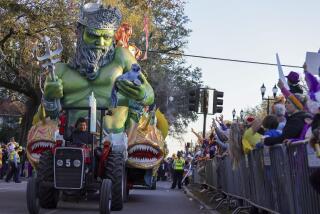Cajun-Style Mardi Gras: Different!
- Share via
NEW ORLEANS — Fat Tuesday without trinkets? Festivities without floats?
Welcome to Cajun country, where Mardi Gras is just as rowdy, but nothing like it is in the Big Easy.
In New Orleans, Mardi Gras is the celebration of privilege, where gaudily costumed faux royalty toss beads to crowds.
On the prairies of Acadiana, masked riders head to local farms, chasing down chickens and begging for the sausage, onions, and other goodies that go into gumbo.
“You haven’t seen Mardi Gras until you’ve been to Mamou and spent the day with a bunch of happy Cajuns,” said Mamou Police Chief Jasper J. Manuel.
Mamou, about 200 miles west of New Orleans, is the capital of the country celebrations. The town of 3,500 residents will swell to 20,000 people by Tuesday for its Courir du Mardi Gras--the running of the Mardi Gras.
Other towns hold their celebrations today.
The Cajun tradition goes back to the 9th and 10th centuries when peasants, low on food after the winter, went from farm to farm begging food. They wore masks to keep their need private, said Larry Miller, a Cajun historian from Iota.
“Acadians brought the Mardi Gras of the peasants with them when they came here in the 1750s,” Miller said. “When New Orleans started their Mardi Gras in the 1800s, it was based on royalty.”
In the little towns that make up Acadiana, more than 100 people, usually men, ride the countryside on horseback, begging for food used in gumbo.
A captain, the only one to know the route, approaches a house or farm with a white flag asking permission for the others to approach. If it’s granted, he lowers the flag as a signal to the masked riders.
Accompanied by a Cajun band, the riders dance for the traditional gumbo makings, which are sent back to town.
In town, cooks prepare the gumbo amid a street dance. The riders, many in costume, return at midday for their share of the Cajun soup.
Manuel and his officers close the party down at midnight.
Word of the celebration has spread, and the crowds have brought some changes.
Crawfish, the delicacy beloved by Cajuns and visitors, has been banned in Mamou during Mardi Gras.
“The people would eat them and then throw the heads and shells on the streets and walk on them,” Manuel said. “By the next morning the stench was so bad we didn’t want to live here.”
Mamou’s eight-person police force is supplemented by 50 officers from surrounding communities, although the most serious problems have been drunkenness and a few fights, Manuel said.
It’s a day well worth the effort, Manuel said.
‘It’s just the most fun in the world,” he said.
More to Read
Sign up for The Wild
We’ll help you find the best places to hike, bike and run, as well as the perfect silent spots for meditation and yoga.
You may occasionally receive promotional content from the Los Angeles Times.






